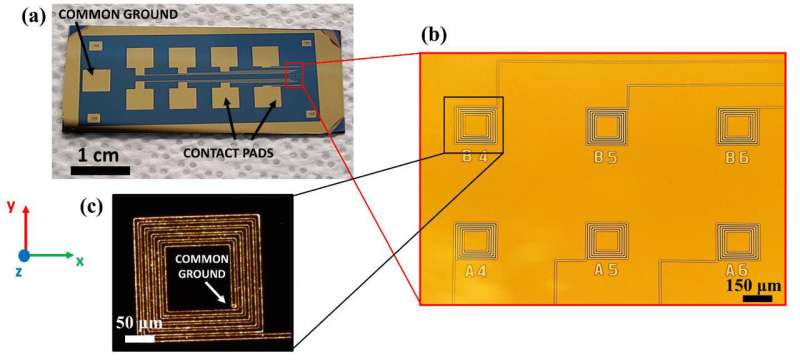This article has been reviewed according to Science X's editorial process and policies. Editors have highlighted the following attributes while ensuring the content's credibility:
fact-checked
trusted source
proofread
Magnetic microcoils unlock targeted single-neuron therapies for neurodegenerative disorders

Neural stimulation is a medical technique used to treat many illnesses affecting the nervous system. It involves applying energy to neurons to encourage them to grow and make connections with their neighbors. Treatments for epilepsy can often include neural stimulation, and similar treatments exist for Parkinson's disease, chronic pain, and some psychiatric illnesses.
In the Journal of Vacuum Science & Technology B, researchers from the University of Minnesota deployed an array of microscopic coils—microcoils—to create a magnetic field and stimulate individual neurons.
Existing devices are effective, but lack the necessary precision needed for some applications, such as cochlear implants or vagus nerve stimulators.
"There are several neurostimulation devices on the market—some are already FDA-approved for patient trials, some are pending approval," said author Renata Saha. "But each of them has one caveat—they stimulate a large population of neurons, including neighboring cells that are not supposed to be stimulated. The medical device industry is in search of a device or technique that can stimulate neurons at a single-cell resolution."
Instead of using an electrode, Saha and her team turned to magnetic coils of wire. Over two centuries ago, physicist Michael Faraday described how electric current running through a coil of wire can create a magnetic field. This magnetic field can then induce an electric field in any nearby neurons—the same effect created by an electrode but much more precise. However, this technique comes with a major downside.
"To achieve the desired threshold of electric field capable of stimulating neurons, the amount of current these microcoils need to drive is extremely high," said Saha. "It is almost three times the amount of current that needs to drive an electrode to achieve the same threshold."
To solve this problem, the team made two improvements. First, rather than a single microcoil, they used an array of eight coils, which combined can induce electric fields using much less current per coil. The authors made further improvements to these microcoil arrays by employing soft magnetic materials, which boost the magnetic strength of the coils.
"Adding these soft magnetic materials at the core of the microcoils increases the electric field without the need to increase the current through the microcoils," said Saha.
The researchers constructed a prototype of their coil array, called MagPatch, and encapsulated it within a biocompatible coating. They then tested it with human neuroblastoma cells to demonstrate its effectiveness. The cells were affected by the magnetic fields without being harmed by the coating, suggesting the potential to use this device in clinical settings.
The authors plan to continue developing and testing the MagPatch device to ensure its safety and utility. They hope it helps to improve the next generation of cochlear implants.
More information: Planar microcoil arrays for in vitro cellular-level micromagnetic activation of neurons, Journal of Vacuum Science & Technology B Microelectronics and Nanometer Structures Processing Measurement and Phenomena (2024). DOI: 10.1116/6.0003362


















